(edit: Months into this tale and it hasn’t ended well with warranty support – be sure to read the updates at the end of this post)
I have to report a kitchen casualty. One of my most trusted pots has fallen in the line of duty.
Years ago on the radio show we did a segment of “the most useful items in your kitchen” and it became so popular that we revisited the topic every few months. The list had a few surprises (e.g. a giant rock from the garden for bashing garlic, plastic lids for mason jars, etc.) but the pillars of that list were fairly predictable. For me fresh garlic, a high-powered blender, a really good food processor, and a dutch oven were the top choices. They still are to this day.
That last item, the dutch oven, has been proven time and time again to be the one pot I’d take with me to a deserted (or “dessert-ed”) island. Its diverse uses have made it the star of my cookware lineup. So much so that I think I’m up to owning four of them at this point of various sizes and from a few different makers. I just can’t resist when I see one on sale knowing full well that I don’t need another but certain that I will use it if I add to the collection. You can braise in them, you can saute in them, you can fit a whole meal in them if you get one big enough. Stove top to oven and back again, you can use a dutch oven anywhere for almost anything. I’ve even seen people bake bread in the blasted things. A range of shapes make cooking everything from cassoulet to coq au vin a snap.
While I know they’re made in a few different materials, cast iron probably accounts for the vast majority of them on the planet and with good reason. It’s durable and holds heat very well. It can also be made relatively inexpensively although the range of consumer price points is vast. Anywhere from $50 for Chinese-made versions up to the premier examples from France in the $350+ bracket. The truth is that they all perform reasonably well because of the inherent qualities of the cast iron. The main difference in various manufacturers is the small details e.g. shapes, colours, finishes around the edges, etc. In general it’s a great material but when you make a hefty version of a classic shape and enamel coat the stuff, it becomes nearly indestructible… or so I thought.
Back when I got my very first ever book advance, I decided to celebrate and splurge with a new dutch oven. I went to the local kitchenware store just after the turn of the millennium and plunked down $354 of my soon-to-be-hard-earned writer’s cash for the end all of dutch ovens, a Le Creuset from France. Or as they insist on calling them, a “French Oven”. Silly French. But boy do they make a great pot. Get the biggest one you can lift for your first and then try, just try to resist buying more over the years to come.
This IS the kitchen soldier you want to command. This is enamelled cast iron that requires two sturdy arms. It’s 6.7 litres of pure cooking glory. This is the pot that Julia used. This is the pot that built a cookware empire. This is one of the most trusted brands in all of the cooking world. This is the pot that’s made a billion meals.
I chose dark blue. Sleek. Stylish. Close race between that and deep red. I resisted their signature orange.
After a decade of using it I liked it so much I went and bought another one exactly like it that was ultimately pilfered from my racks by a friend that probably deserved it for putting up with me over the years. This is the sort of pot that’s made to last. You could hand it down through the generations if that’s your sort of thing. You see decades-old examples in estate sales all the time still just as functional as the day they were cast. As I said before I thought it was impossible to kill one until I started to cook on Thanksgiving day this week.
I need to back up a few months in this tale. My beloved dutch oven had given a clue to coming events several months earlier. There were two tiny pinholes that appeared in the enamel at the base of the pan. One showed a year earlier, fourteen years after I bought the pot in 2000, but was so shallow that it was hard to even notice. You could feel it more than you could see it. The second showed up later in 2014 and I noticed it then only because water from washing left in the pot revealed a tiny whisp of rust. Easy enough to fix, just don’t leave water in the pot I thought. It wouldn’t be any worse than cooking in cast iron that wasn’t enamelled, something I do plenty of in other pans. Just ask my cornbread.
Still, I called Le Creuset just to see if I should worry and had a lovely chat with a woman named Sarah on the phone who asked me to email some photos which I did at the time. I left it with them to contact me if they felt it was an issue. Since I never heard back from any alarmed cookware engineers spelling out explosive kitchen doom, I assumed it wasn’t a problem and went merrily along in my dutch oven life. I continued to cook with perhaps just a bit more care towards the bottom but it kept performing as well as it always had.
It’s worth pointing out here that I only wash it by hand with a bit of dish soap and one of those blue ‘made for delicate surfaces’ scrubby pads. Nothing I cook ever gets so bonded to the surface that a bit of water soaking and patience can’t get it out. There are the odd scratches here and there from an errant ladle or the wrong spatula grabbed by guest cooks but nothing that would approximate an abuse test occurs in my kitchen domain. Of course they slip a catchall phrase into the warranty about overheating but I’m usually a medium heat sort of guy in this pot. Granted I’ve got no clue how they measure that since ‘medium heat’ is really a vague sort of qualification and I hope it’s not just a corporate excuse to gouge the customer base in such situations.
I started a dish in the usual manner on Monday for the holiday up here. Medium heat and a bit of olive oil with a diced onion tossed in. I turned my back for about a minute to tend some cranberries and grab some stock as I waited for the sizzle I had heard so many times before from my trusty Le Creuset. Instead, I got a ‘pop-pop’ noise three or four times in rapid succession. I was so confused I even looked at the popcorn popper first before realizing it was coming from the dutch oven. I peered in and saw tiny flecks all over my onion as if I had already added the pepper despite the pepper mill still lurking across the kitchen as it tends to do when it’s feeling neglected.
Closer inspection revealed that those flecks were actually shards of enamel that had exploded off the bottom surface of my dear old kitchen workhorse. It even ‘popped’ one more spot of the ruddy stuff at me as I was trying to sort out what had happened. In thirty years of cooking this was a new one on me. I’ve cooked in all manner of enamelled cookware, cheap to expensive, over fires and electric, pristine condition to battered and beaten, any situation you could fathom in the kitchen and some you’d probably never imagine (ask me about some of the McGyver’ed beer brewing experiments someday). Never once have I seen an explosive failure of this sort.
I doubt that this is a safety issue. While that last pop did head towards my eye I had to be staring straight at it to be in the line of fire. I suspect you could ingest tiny bits of enamel without killing yourself but don’t quote me on that. No, I think the worst that could happen here is that you end up with a ruined pot roast or a gritty casserole and a few hours wasted kitchen effort. Maybe if you’re really unlucky some expensive ingredients end up in the bin. Some, including myself, might call that a catastrophe but it won’t likely be the worst day of your kitchen life.
Of course the reason you pay through the nose for good cookware is the reputation of the people that make it. Conveniently here in Canada we have our very own connection to the French motherland by way of Quebec and that’s where the Le Creuset offices I chatted with before are located. I’m going to reach out to them again this week to report the event and see what can be done as I’m sure something can and will be from such a good company. (edit: see the updates below, my faith is wavering more each day in Le Creuset) I doubt they ‘re-enamel’ cookware but since it carries a lifetime warranty, they must have a procedure in place. I just hope it doesn’t cost me an arm and a leg to ship this heavy pot all over Canada or indeed points farther afield. I love owning one but it weighs a tonne and shipping won’t be cheap if that’s what I’m asked to do. I only paid $55 on Boxing Day for the generic backup version that has taken over duty while the French front line is on the injured roster.
I can’t imagine their phone rings for this sort of problem often since the cookware is tough as nails but still, the fashion in which mine failed gives me pause. I’ll be sure to update this post as I hear from them so you all know how the story unfolds. Had a similar experience? Been through a warranty claim yourself? Tell us all about it in the comments section below so we can all learn from your trials and tribulations.
Update 1: I’m adding a few more photos below so the good folks at Le Creuset Canada can see the damage. They’ve ‘received my email’ so that’s some small progress today.
Update 2: I’m not alone. Apparently this enamel damaged path has been tread before by fellow cooks. I feel a sense of damaged dutch oven solidarity now.
Update 3: A week after getting the “we’ve received your email” message, I’ve not heard even a whisper from Le Creuset. This is not encouraging. I assumed there would be some queue but is a week for even a short answer too much to ask? Anyone else had this sort of response (or lack thereof) from them?
Update 4: It’s now been a month and not so much as a peep from Le Creuset. Calls to their Quebec number send me to voicemail, which I’ve left, with no reply. Very frustrating and from what I can read online, the warranty replacement is a crap shoot. You’re in for shipping costs and then if they decide you’re not worthy, you’re in for another $100+ for a ‘discounted’ replacement. Sure that’s still a bargain on a new pot but when similar competitors are going to be less money than the cost and hassle of warranty, do I really want another Le Creuset? Opinions? Experiences from Canadian Le Creuset?
Update 5 (possibly the last): The New Year is here but communication from Le Creuset Canada is not. Not a word from them even after bi-weekly voicemails being left and a handful of emails since Thanksgiving for good measure. Their automated reply says they get them, they just don’t get around to doing anything it seems. I picked up another backup dutch oven on Boxing Day for $53 from a different maker. I’m am now officially disappointed in Le Creuset customer service and have set my replacement budget for the dead pot at $60 (for post and any other charges, if they ever decide to answer me). After that, I’d rather have multiples of my very satisfactory budget replacement. As I said above, the reason you pay the price of brand name is the reputation and support. I’ve not gotten a nickel’s worth from them let alone $300+. Shame to see such a (previously) trusted company drop the ball like this.


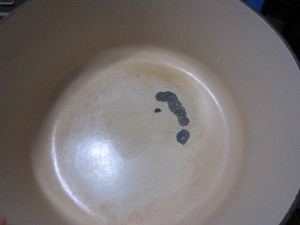
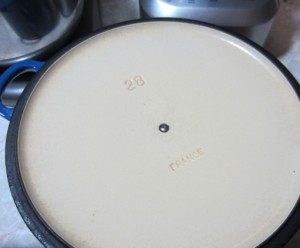
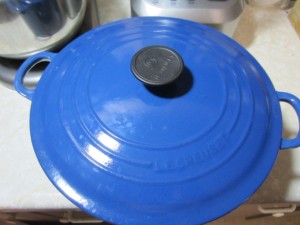
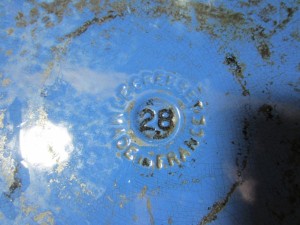
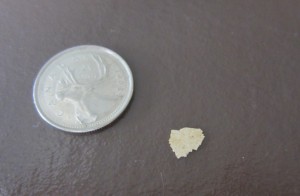
Bobbi
18 July, 2016Funny, I had the same experience with Le Cuistot. On my fourth use, simmering bone broth. Le Cuistot also has NO CUSTOMER SERVICE, and although they claim to have a warranty – I guess if they don’t communicate with you . . . then they don’t need to honour it.
Mr.Spork
18 July, 2016Yikes. At least I got several years use out of the Le Creuset before it popped. It really is a shame all the manufacturers seem to drop the ball on warranty these days. I suspect their accountants assume people won’t bother if they throw up enough roadblocks and red tape for warranty claims and will simply give up. What they don’t seem to realize is that we also won’t bother buying their brands again. Thankfully my two $50 generic replacements seem to be holding up well. No over-priced brand names for me any longer. Cheers!